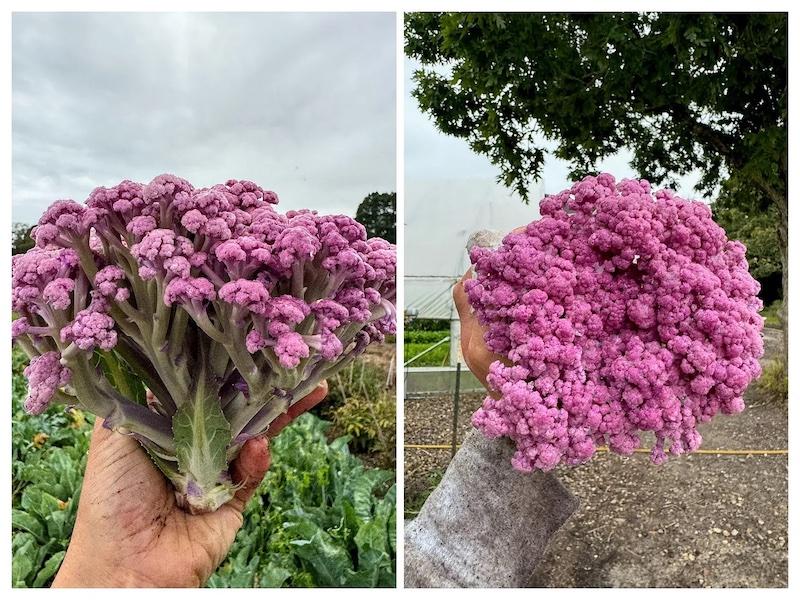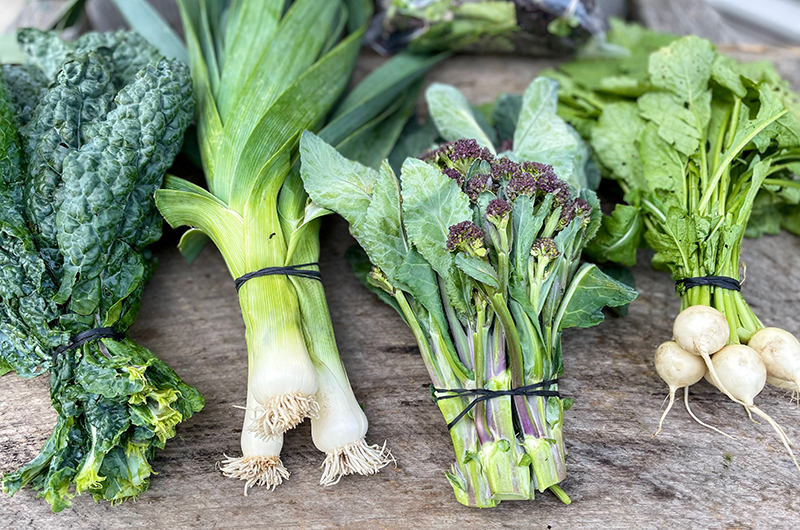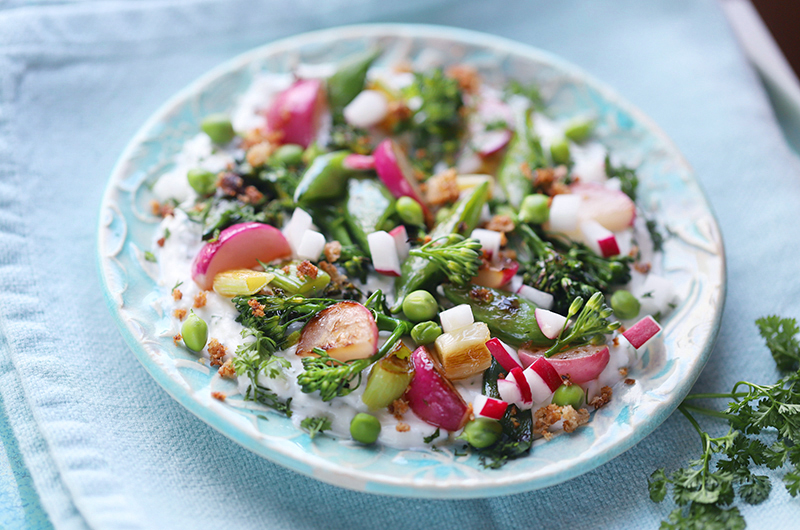There was that blissful moment every spring – a spark of joy I felt when I opened the farm stand for the first day of the season. I had bright bunches of radishes, neatly labeled bags of freshly cut and washed salad mix, little vase-shaped heads of baby bok choy. People who stopped by were so excited to have fresh greens after the long winter, and their enthusiasm was palpable.
It didn’t last long, though. Soon folks would begin to ask me, “Do you have anything else other than greens?”
I’d feel bad and hunt around the gardens looking for things to fluff up the farm stand – bunches of mint and chives, perhaps some youthful (very youthful) spring onions. I would stare at the rows of carrot seedlings, pull a tiny carrot or two, and sigh. It would be another month before the peas would begin to flower. The fact that my mustard greens were flourishing didn’t make me feel better; mustard greens were not exactly popular. However, I was such a small grower that I was usually able to sell pretty much everything I harvested.
Eventually I did get a little better at filling in the gaps – I grew carrots under fabric row cover and got an earlier harvest. I planted baby bok choy in succession, starting a new batch every few weeks. I discovered how quickly those succulent little Japanese turnips grow in the spring. And I was a pea-grower extraordinaire! Starting them under fabric row cover protected them from birds and speeded germination, moving them a wee bit earlier. But that’s as far as my skills and time got me.
Even though I don’t have the farm stand anymore, I still get that fluttery feeling of excitement when spring finally arrives on the Vineyard and then lunges into early summer. These days I watch with admiration while Island farmers bring us an even bigger variety of spring vegetables – and earlier in the season too. How do they do it, I wonder? And what are they looking for when they choose what to grow and how to plant it to get a jump on the season?
I knew just who to ask – Beetlebung Farm director Kate Woods. Unless you’ve avoided the West Tisbury Farmers’ Market in recent years or haven’t driven to Chilmark to visit Beetlebung Farm’s charming farm stand, you couldn’t have missed the gorgeous vegetables that Woods, Nick Doherty, and the rest of the Beetlebung crew – which includes Islander Theo Gallagher and Island transplant Leo Sedlock – are growing at Beetlebung.
Another reason that I love to talk to Woods is that she’s a great cook too, so she’s always thinking about the entire progression – from seed to ground to harvest to table.
A few weeks ago, I drove up to see her and sat with her at a seeding table in one of the high tunnels (hoop house), the air fragrant and warm, the light gauzy and peaceful.
One of the first things she told me was that because last-frost dates are moving earlier on the Island – by as much as ten days – the end of winter and the beginning of spring are starting to blur together, allowing farmers (and home gardeners) to plant carrots, bok choy, and some greens a little earlier than usual.
Of course, like most farmers these days, Beetlebung is using tunnels, like the one we were sitting in, to blur that line even more. Two years ago, Beetlebung set a goal to plant peas in one of the tunnels and to harvest them earlier than any field crop could possibly match. It worked. I couldn’t believe my eyes when I saw the farm’s Instagram post in early May of that year showing sugar snap peas on the vine.
The second part of the plan was to also plant a field crop of peas at the usual time, thereby making a second wave of peas available to customers after the vines in the tunnels stopped producing. (Peas do not like heat, so to grow them inside, ventilation must be good.) That also worked beautifully.
Woods and Doherty scour specialty websites and catalogues to trial new vegetables and varieties, and one they’ve successfully introduced over the last few years is noble Jade, or Chinese broccoli (also called gai lan). It yields particularly tender and flavorful stems and flowerets. Slightly mustardy, but not as bitter as broccoli raab, noble Jade is perfect for a classic garlic-and-red-chile treatment you might do for other greens.
For other promising Asian vegetables to grow, Beetlebung has turned to Kitazawa Seed Co. in the past, and this year will be growing some interesting finds from the Tokita Seed Company’s Oishii Nippon Project. Tokita started this project in 2018 to bring high-quality Japanese vegetables to the attention of farmers and eaters.
Of the Oishii Nippon seeds, Woods is most excited about a vegetable called negi, an ancient Japanese vegetable that is a member of the allium family. It is a bit like a cross between a scallion and a leek. It is repeatedly buried in soil as it grows to give it an extremely long, blanched stalk. Beetlebung will also be trying out the company’s murasaki fioretto, a purple version of the white sprouting cauliflower called fioretto.

From Johnny’s Selected Seeds comes a red trumpet Chinese cabbage, a more open, vase-shaped variety that Woods is hoping may not trap as many pests as the closed cabbages tend to do. She’s also added a stunning new baby bok choy from TomorrowSeeds called golden heart to the lineup. I can see many of these vegetables, sliced or diced, working well in okonomiyaki, a Japanese vegetable pancake.
Of course, the peas will once again be planted in a tunnel. Carrots, radishes, and Japanese turnips, as well as spinach, kale, and salad mix (a.k.a. party mix) will also make it from the fields to the Beetlebung farm stand this spring.
With so many options, I couldn’t help but ask Woods what she feels like cooking once spring arrives. She told me she craves bright, acidic flavors and loves a late-spring palate that combines both foraged and cultivated ingredients. She likes the freshness of watercress and the surprise of nettles combined with farm-grown greens and lettuces and a bright, acidic vinaigrette.
“I want some bitter for rejuvenation and freshness after the more warming flavors of winter,” she said.
One favorite late-spring dish is fresh English peas with lemon and ricotta. Something she made a lot of last spring was a dish of green gnudi, a ricotta dumpling she enhanced with lots of herbs, nettles, arugula, and Parmigiano. She would finish the gnudi by searing them in plenty of butter and making a pan sauce from fresh and preserved lemons and fresh peas – yum!
She also likes serving fresh peas and other spring veggies, lightly cooked, on a thick swath of Greek yogurt that she’s stirred lots of herbs into. When she described this idea to me, I laughed because I am an admirer of her fresh and light approach to cooking and composing dishes, whereas I tend to want my vegetables to carry umami, so I’m always caramelizing them by roasting, sautéing, or grilling.
I decided, in Woods’s honor, to devise a vegetable recipe for this column that would seem like a happy marriage of our two approaches. The result is a lovely, light stir-fry of spring vegetables (I get my umami) served atop a robust lemon-dill yogurt sauce (Woods-style) and garnished with some finely diced raw vegetables for her and some fried breadcrumbs for me. Well-balanced, fresh, colorful, and delicious – the best of spring on a plate.








